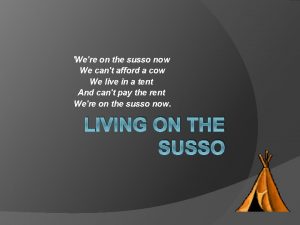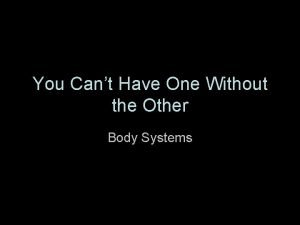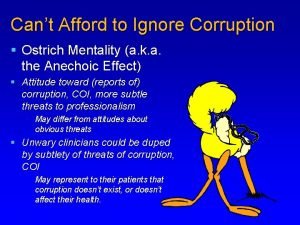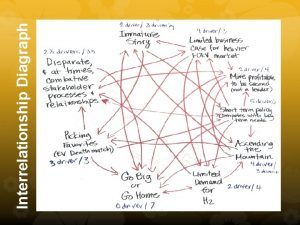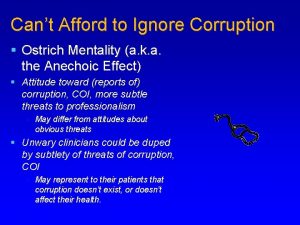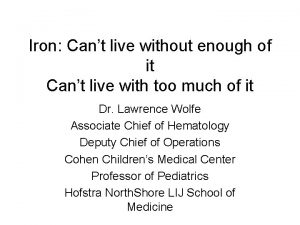Were on the susso now We cant afford









































- Slides: 41

'We're on the susso now We can't afford a cow We live in a tent And can't pay the rent We're on the susso now. LIVING ON THE SUSSO

David Potts and His Myth Tradition has it that the Great Depression of the 1930 s swept through Australia like a raging flood, tearing up the garden of the 1920 s and imposing terrible suffering on the population at large. . Ever since, popular images of impacts have included men and women evicted onto the streets, eating out of dustbins, queuing for the dole, living in humpies, and tramping the countryside in search of work. � Many of the respondents recalled painful experiences, as he anticipated. But others spoke of the early 1930 s with affection. They said that they had coped well, that the Depression ‘gave life meaning’ and that ‘people were happier then’. �

Brother Can You Spare a Dime? � They used to tell me I was building a dream And so I followed the mob When their was earth to plow or guns to bear I was always their right on the job They used to tell me I was building a dream With peace and glory ahead Why should I be standing in line Just waiting for bread? Once I built a railroad, I made it run Made it race against time Once I built a railroad, now it's done Brother, can you spare a dime?

JOB COMPETITION

Advertising?

Streetsellers

Evictions It was recorded in Sydney in 1932 that over a period of twelve months, applications for evictions reached 5000. As the depression ground on, chronic unemployment, high interest rates, mortgages and rentals resulted in the eviction of many families from their homes. Without a job for 3 1/2 years, Mr William Roberts, an original Anzac, stands with his wife and two of their three children beside their meagre belongings.

TOUGH MEN HARD TIMES Between June 1931 and June 1932 a surreal, new type of public disturbance, known as the ‘anti-eviction riot’, became a part of daily life in New South Wales. Signs such an event was imminent appeared in defiant messages scrawled in chalk on working-class cottages and terraces in suburbs like Redfern, Bankstown and Newtown in Sydney, and at Tighes Hill in Newcastle. Huddles of determined men then set about erecting barricades, using barbwire, sandbags and whatever else came to hand. Negotiations to quit the property typically failed and the police, as was their way during the Depression, went in hard. Chunks of bluemetal, stones and bricks ripped through the air. Doors were kicked in. Batons and iron-bars rose and fell. In one instance, 17 bullets smashed into external walls as police, in frustration, let loose with their guns. The eviction riots were both tragic and ferocious. At Tighes Hill in Newcastle 200 men battled 60 police for over an hour with weapons including a sledgehammer.

Black Friday in Newtown � The Sydney Morning Herald described one such battle in Newtown, Sydney in June 1931. "The most sensational battle Sydney has ever known was fought between 40 policemen and 18 Communists. . . All the defenders were injured, some seriously. " Bullets flew, one man was hit. "Entrenched behind barbed wire and sandbags, the defenders rained stones weighing several pounds from the top floor of the building on to the heads of the attacking police, who were attempting to execute an eviction order. "A crowd hostile to the police, numbering many thousands. . . threatened to become out of hand. . . When constables emerged from the back of the building with their faces covered in blood, the crowd hooted and shouted insulting remarks. "

CHANGING POLITICS � In this context it is hardly surprising that the Communist Party's propaganda about the final crisis of capitalism and the urgent need for a revolution struck a chord. At the start of 1930, they had 300 members, by 1934 there were nearly 3, 000. Its paper, The Workers' Weekly, had sales of about 2, 000 in 1928, but by 1931 this had risen to 10, 000.

Unemployed Workers Movement When the Great Depression first hit Australia and a great wave of unemployment engulfed the country, there was no unemployment insurance for eight months. � A national Unemployed Workers Movement (UWM) was set up in Sydney in July 1930. In the big cities there were repeated demonstrations of the unemployed. These actions won the dole and the first payments were made in June 1930. � The UWM often spearheaded struggles against evictions. Some of these actions were veritable battles against the police attempting to evict people from their homes and throw them onto the street. The UWM also fought for improved conditions for the unemployed. These struggles were successful in winning higher dole payments and in gaining a rent allowance for the unemployed to stop people being evicted from their homes. �

WHERE TO? Families unable to pay rent were evicted and forced to live in substandard accommodation, often with no running water, electricity or gas. � Sometimes, several families would share a house, with each family crammed into one room. � Others lived in public spaces such as Sydney’s Domain, in makeshift shelters constructed of corrugated iron and hessian sacks. � The last resort was the makeshift SHANTY TOWNS on the outskirts of towns. Engadine began as a shanty town �

HAPPY VALLEY Identify the building materials used to construct the homes Many families joined large groups of people who had to live in what were called 'shanty towns. ' These towns usually comprised a number of shelters on the outskirts of a town. The shelters were made from scrap materials which included corrugated iron, cardboard, planks of wood, and hessian bags. It was particularly the 'Happy Valley' community in Sydney's La Perouse which was the best-known. Here, as in most other 'shanty towns', they had no running water, the inhabitants having to collect it from 1. 5 kilometres away. The struggling residents also had to endure inadequate food, usually living on bread and dripping, the fat from cooked meat. Some also joined long queues to be fed by soup kitchens. With a lack of nutrition and sanitation, the areas became rampant with diseases such as dysentery, scurvy and lice.

What differences do you see between the photos?

Conditions in the SUSSO camps The shacks and tents, built by the unemployed at Happy Valley, were constructed from scavenged scraps of corrugated iron, hessian, wood and even cardboard. Walls were often made of cloth flourbags that were cut open and resewn into squares to fit the timber frames. The 'bag’ walls were painted with a mixture of lime and fat boiled up in salt water to make them weatherproof. The roofs consisted of corrugated-iron sheets and the sand floors were smoothed out and covered with more flourbags.

� � � Another account of life in Happy Valley, 1934 We’ve lived, 400 men, women and children, in our bag humpies in this fleainfested stretch of grubby sand hills … sheltered from the southerly busters*that sweep across Botany Bay. Have a look inside the shacks that look so dilapidated from the road. Bags, these walls, flour bags bummed from the baker, cut open and re-sewn into squares to fit the white-anted, second-hand timber that forms the jerry built walls; painted with a mixture of lime and fat boiled up in salt water to make them weatherproof. The roofs are mostly made of scrap sheets of tin rescued from the garbage tip. . . the floors are wet sand, smoothed out and covered with more bags. Fleas? Millions of ’em! Worker’s Weekly, February 1934

Boat Harbour and Kurnell Why here?

Living under a cliff at the Domain 1932

JUMPING THE RATTLER Men who lived in the city which was overflowing with unemployed people, often went 'on the track' which was where they walked, travelling around the countryside in the hope they could pick up some odd jobs, perhaps on farms. Some of these men needed to travel such great distances and as they had no money to do so, would 'jump the rattler, ' otherwise known as hitching the freight trains, without paying a fare

� For those who could find work, their standard of living was not necessarily any better. In 1933, 17 percent of people earned less than four dollars per week

WAYS TO SURVIVE � “People were forced into all sorts of tricks and expediencies to survive, all sorts of shabby and humiliating compromises. In thousands and thousands of homes fathers deserted the family and went on the track (became itinerant workers), or perhaps took to drink. Grown sons sat in the kitchen day after day, playing cards, studying the horses [betting on horse racing] and trying to scrounge enough for a threepenny bet, or engaged in petty crime, mothers cohabited with male boarders who were in work and who might support the family, daughters attempted some amateur prostitution and children were in trouble with the police. ”

Women For many families, survival depended on the women having dual responsibilities of breadwinner and homemaker. Employment for married women was restricted and exploitation of cheap female labour and cost cutting was common. The Australian arbitration system set the basic female pay at 54% of the male rate and wasn't enough to support a family. � Women worked in jam and pickle factories, sewed clothing or were domestic servants living in the homes of the wealthy. Employment in factories was dirty and dangerous but always in demand. In many homes, daughters, mothers and sisters came to provide the major source of income. � The women were usually the ones in the household who went without food or medicine for the good of their children. The burden of keeping a household running was placed on women and many were brought to the point of despair �

MAKING DO! A WOMAN HOLDING A HOMEMADE WATERING CAN AND A SPADE. THE WATERING CAN HAS BEEN MADE FROM A SHELL PETROL TIN. THE HANDLE OF THE SPADE HAS BEEN CON- STRUCTED FROM A FORKED BRANCH. Many city people transformed their flower gardens into vegetable gardens in an attempt to provide some nutrition and some self-sufficiency

BREAD AND DRIPPING � People frequently went hungry during the Great Depression. They often ate bread and dripping and 'cocky’s joy’ (bread and golden syrup). State government relief schemes kept many unemployed men and their families alive, and single men who could prove they were destitute were paid a sustenance wage (the 'susso’) to work on government-financed public work schemes. Others had to rely on charitable groups that ran soup kitchens or provided some limited monetary assistance and basic food rations.

RABBIT STEW � During the tough economic times of the Great Depression of the 1930 s, the rabbit became a welcome commodity rather than the pest it had been to farmers. The skins could be sold for money and the meat was often the only option available to poor families. Rabbits could be caught fairly readily even in the outskirts of big cities such as Melbourne, in suburbs that are now densely populated.

Six o clock swill Women seeking change Change was sought by a referendum to curb men's drinking, because they saw men's drinking as jeopardising the wellbeing and safety of people in the home, of mothers and children, in all sorts of ways. Drinking took the money that was meant to go to clothing and food, that drinking made men violent, that drinking generally destroyed the community of the family

� Alternatively, a few men were able to take part in the State government's 'work for the dole' scheme. This meant that they worked on public infrastructure such as improving the rail and roads, as well as building water towers and digging canals. However, the conditions were inadequate, they could be sent to remote areas and their dole payments could be cancelled if they turned down any work. The most demoralising factor was that for all of their hard work, they received an income which was below the basic wage.

The Susso Those who were unemployed were entitled to the application of the 'susso', a sustenance or dole payment. A person seeking this assistance had to register and demonstrate that they had been unemployed for at least the previous two weeks. � Payment was on a family basis, firstly in the form of rations, then a cash order system was introduced. The working class was demoted to an image of dole queues, shanty towns, unemployed men and protesting marchers. Those who had to queue for the dole were humiliated; most states didn't provide cash but merely food coupons. �

SUSTENANCE CAMPS 1930’S The Government established “Susso” or relief camps to occupy previously unemployed men. Comfort was not a priority in these camps; men were issued with a tent, tent fly, three sheets of corrugated iron to make a chimney, two blankets, frying pan, wash dish, set of floor boards, hurricane lamp and fencing wire.

Government Projects Alternatively, a few men were able to take part in the State government's 'work for the dole' scheme. This meant that they worked on public infrastructure such as improving the rail and roads, as well as building water towers and digging canals. However, the conditions were inadequate, they could be sent to remote areas and their dole payments could be cancelled if they turned down any work.

Reclaiming Manly Lagoon A sustenence project


Feeding the Hungry; Schools and Soup Kitchens

SUFFER THE LITTLE CHILDREN Children also felt the force of the Depression. Schools tried to assist students by feeding them and clothing them with what resources they had. Despite this, many children were forced to leave school prematurely so that they could find a job or look after the household, enabling their parents to look for work. Often children and youths, which included anyone under the age of 21, were paid a lower wage than adults which made them attractive to employers. However, once these youths turned 21 they were often immediately dismissed and replaced with younger employees.

St Vincent De Paul Boys Orphanage 1936 The Great Depression caused hardship and suffering on the community, which resulted in unprecedented demands on the orphanage and its resources. Around 1935 permission was granted by Archbishop Mannix to allow for an additional fifty boys to be admitted to the orphanage. This involved enlarging dormitories by building ‘sleeping-out balconies’ across the front of the west elevations of the north and south wings. Also a second storey was added to the 1850 s building and the orphanage dining room was enlarged.

Mathew Talbert Hostel � It opened in 1938 as the Matthew Talbot Hostel with 11 beds for overnight accommodation, and about 100 meals a day were served. By 1943 it had grown to 17 beds and 143 meals a day. Today the building site in Kent Street Sydney is now the Genesian Theatre

Sydney City Mission � In response to growing poverty during the Great Depression, Sydney City Mission established soup kitchens at most of its services. Coffee bars were also opened to distribute cheap meals, clothing and blankets.

HEALTH OF THE UNEMPLOYED � Diseases associated with under- nourishment, such as rickets, were common. � Other more serious diseases were Tuberculosis, Diphtheria, Typhoid and Whooping Cough � Other health issues were alcoholism and Depression.

SOCIAL CHANGES working class children consistently leaving school at thirteen or fourteen years old � married women carrying a greater domestic burden: home -making was still considered a woman's role, so even if a woman had worked all day scrubbing floors to bring in some money, her unemployed husband would still expect her to cook dinner and keep the house in order � jobs being easier to find for young people, but the work had little future career prospects and many young workers were sacked by the time they turned sixteen, eighteen or twenty-one years of age � migrants, particularly those from Italy and southern Europe, being resented because they worked for less wages than others despite having relatively little in the way of family or friends to call on for help �

MUSIC AS A WINDOW TO THE SOUL � Why don't you work like other men do? How the hell can I work when there's no work to do? Chorus : Hallelujah, I'm a bum Hallelujah, bum a gain! Hallelujah, give us a handout To revive us again.

IMPACT OF THE DEPRESSION ON THE UNEMPLOYED
 The susso
The susso If you cant measure it you can't manage it
If you cant measure it you can't manage it If you cant measure it
If you cant measure it Wash kelimesinin 3. hali
Wash kelimesinin 3. hali Nvcc afford
Nvcc afford How do these screen objects afford?
How do these screen objects afford? How do these screen objects afford
How do these screen objects afford Now i see it now you don't
Now i see it now you don't Jeb likes cars but he cant drive yet
Jeb likes cars but he cant drive yet If you can't measure it you cannot improve it
If you can't measure it you cannot improve it Rail cant
Rail cant Atunci iti cant maret stapanitor
Atunci iti cant maret stapanitor Eric ribbens
Eric ribbens Close your eyes and imagine story
Close your eyes and imagine story Reglet waterproofing
Reglet waterproofing Cant judge a powder
Cant judge a powder I cant count
I cant count Natural materials
Natural materials Why we cant see air
Why we cant see air Gabriel mpubani
Gabriel mpubani I can could speak english but i can't write it very well
I can could speak english but i can't write it very well From can to cant
From can to cant Male vs female skeleton pelvis
Male vs female skeleton pelvis The provision of equilibrium cant be seen in case of
The provision of equilibrium cant be seen in case of Verb x
Verb x You can't have one without the other examples
You can't have one without the other examples If you can t beat them join them
If you can t beat them join them I bet you cant
I bet you cant Bleeding
Bleeding Cant deficiency in railway formula
Cant deficiency in railway formula You cant manage what you dont measure
You cant manage what you dont measure Why cant we see atoms
Why cant we see atoms Cant cove base
Cant cove base Future in the past was were going to examples
Future in the past was were going to examples Quá trình desamine hóa có thể tạo ra
Quá trình desamine hóa có thể tạo ra Môn thể thao bắt đầu bằng chữ f
Môn thể thao bắt đầu bằng chữ f Khi nào hổ mẹ dạy hổ con săn mồi
Khi nào hổ mẹ dạy hổ con săn mồi Thế nào là mạng điện lắp đặt kiểu nổi
Thế nào là mạng điện lắp đặt kiểu nổi Hát kết hợp bộ gõ cơ thể
Hát kết hợp bộ gõ cơ thể Dạng đột biến một nhiễm là
Dạng đột biến một nhiễm là Nguyên nhân của sự mỏi cơ sinh 8
Nguyên nhân của sự mỏi cơ sinh 8 độ dài liên kết
độ dài liên kết
